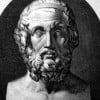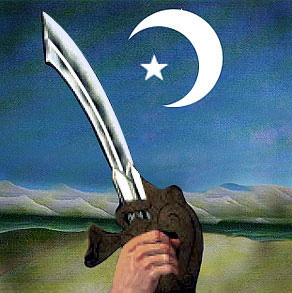Buddhist sources: Jesus in India
Hi friend Hokey
How do you know that Jesus was not real?
Thanks
I am an Ahmadi peaceful MuslimHi friend Beelzedad
Quran mentions Jesus; so he was real.
Thanks
Hi friends
About Buddhist sources for Jesus in India; Mirza Ghulam Ahmad further elaborates:
As I have just now stated, there is such a striking resemblance between the moral teaching of the Buddha and that of Jesus, that for those acquainted with both it has become something surprising. For example, the Gospels say: do not resist evil, love your enemy, live in poverty, shun pride and falsehood and greed. The same is the teaching of the Buddha6. Nay, the Buddhistic teaching lays greater stress on it, so much so that the killing even of ants and insects has been declared a sin.
The outstanding principle of Buddhism is: sympathy for the whole world; seeking the welfare of the whole of humanity and of all the animals; promotion of a spirit of unity and mutual love. The same is the gospel teaching. Again, just as Jesus sent his disciples to different countries -- journeying to one himself -- so was the case with the Buddha. Buddhism by Sir Monier Monier Williams records that the Buddha sent out his disciples to preach, addressing them thus: 'Go forth and wander everywhere, out of compassion for the world and for the welfare of gods and men.
Go forth, in different directions. Preach the doctrine (Dharham), salutary (Kalayana) in its beginning, middle and end, in its spirit (artha) and in its letter (vyanjana). Proclaim a life of perfect restraint, chastity and celibacy (Drahmacariyam). I will go also to preach this doctrine' (Mahavagga 1.11.1)7. The Buddha went to Benares and performed many miracles in that territory; he delivered an impressive sermon on a hill just as Jesus had delivered his sermon on the mount. Again, the same book states that the Buddha preached mostly in parables; he explained spiritual matters by means of physical analogies.
http://www.alislam.org/library/books/je … a/ch4.html
Jesus did not did a cursed death on Cross; he survived and migrated to India; where he died a natural and peaceful death at the age of 120/125 years, according to some traditions.
Thanks
I am an Ahmadi peaceful MuslimHi friends
More from Mirza Ghulam Ahmad 1835-1908
Let it be remembered that this moral teaching and this mode of preaching, i.e., talking in parables, was the method of Jesus. This mode of preaching and this moral teaching, combined with other circumstances, at once suggest that this was in imitation of Jesus. Jesus was here in India; he went preaching everywhere; the followers of the Buddhist Faith met him, and finding him a holy person who worked miracles, recorded these things in their books; nay, they declared him to be the Buddha, for it is human nature to try to acquire a good thing for oneself wherever it may be, so much so, that people try to record and remember any clever remark made by any person before them.
It is, therefore, quite likely that the followers of the Buddhist Faith may have reproduced the entire picture of the Gospels in their books; as for example, fasting for forty days both by Jesus and the Buddha; the Temptation of both; the birth of both being without father8, the moral teaching of both; both calling themselves the Light, both calling themselves Master and their Companions disciples;
just as Matthew, chapter 10 verses 8 and 9, states: 'Provide neither gold, nor silver, nor brass in your purses,' so the Buddha gave the same command to his disciples; just as the Gospel encourages celibacy, so does the teaching of the Buddha; just as there was an earthquake when Jesus was put on the Cross, so it is recorded, these was an earthquake at the death of the Buddha. All these points of resemblance arise from the fact of Jesus' visit to India, which was a piece of good luck for the followers of the Buddhist Faith, from his staying among them for a considerable time and from Buddhists acquiring a good knowledge of the facts of his life and of his noble teaching.
Consequently, it was inevitable that a great part of that teaching and ceremonial should find its way into Buddhistic records for Jesus was respected and taken for the Buddha by the Buddhists. These people, therefore, recorded his sayings in their books and ascribed them to the Buddha.
http://www.alislam.org/library/books/je … a/ch4.html
Thanks
I am an Ahmadi peaceful MuslimYou said.
"Mirza Ghulam Ahmad 1835-1908 has mentioned in his book..."
That would be 1000, 800, 30, 5years (at least) later than when Jesus lived.
That is SOLID evidence of the facts.
I'm (almost) convinced.
Jesus in India by Mirza Ghulam Ahmad 1835-1908
It is indeed a wonder that the Buddha, just like Jesus, should have taught his disciples in parables -- especially in those to be found in the Gospels. In one of these parables the Buddha says:
As the peasant sows the seed but cannot say: the grain shall swell today, tomorrow germinate, so also it is with the disciple; he must obey the precepts, practise meditation, study the doctrine; he cannot say today or tomorrow I shall be delivered 9.
This, it will be noted, is the same parable which has existed in the gospels to this day. The Buddha, again, narrates another parable:
Again as when a herd of deer lives in a forest a man comes who opens for them a false path, and the deer suffer hurt, and another comes who opens a safe path and the deer thrive; so when men live among pleasures the evil one comes and opens the false eightfold path of right belief... (P. Oldenberg, 191-192).
The Buddha also taught:
Righteousness is a safe Treasure which no one can steal. It is a Treasure which accompanies man even after death; it is a Treasure which is the Source of all Knowledge and all Perfection. 9
Now it will be noticed that the gospel teaching is just the same. The ancient Buddhistic records of this teaching belong to the period not remote from the time of Jesus -- nay, it is the same period. Again, on page 135 of the same book there occurs the saying, wherein the Buddha speaks of his irreproachableness in that no one could point to a blot on his character. This too has a resemblance with a saying of Jesus. Buddhism, on page 45, states:
The moral teaching of the Buddha has a striking resemblance with the Christian.
I agree; nay, I acknowledge; both say: Love not the world; nor wealth; do not hate your enemies; do no evil; conquer evil with good; do to others as you wish to be done by -- all this points to such a striking resemblance between the gospel and the teaching of the Buddha that it is unnecessary to mention any more details.
Buddhistic records also show that Gautama Buddha prophesied the advent of a second Buddha who was named Metteyya. This prophecy is contained in Laggawati Sutatta -- a Buddhist record. It is mentioned on page 142 of Oldenberg's book. The prophecy reads 10:
He will be the leader of a band of disciples numbering hundreds of thousands, as I am now the leader of bands of disciples, numbering hundreds.
http://www.alislam.org/library/books/je … a/ch4.html
Thanks
I am an Ahmadi peaceful MuslimThe essence of the teachings of enlightened ones is the same.
Hi friend mohitmisra
I agree with you; because their source was one, Word of Revelation from the Creator- God Allah YHWH. But Buddhism and Buddhists have lost the Word of Revelation, to the extent that they deny his source of enlightenment was the Revelation he received from the creator- God Allah YHWH.
In a way when the Chrstians lost the Revelation , they made Jesus a god totally against the teachings of Jesus; when the Buddhists deviated from Buddha; they maintained Buddha had no revelation and he did not believe in God Allah YHWH.
When Jesus came to Indie, he he remedied the situation.
Thanks
I am an Ahmadi peaceful MuslimBuddhists have lost the Word of Revelation, to the extent that they deny his source of enlightenment was the Revelation he received from the creator- God Allah YHWH.
Not all Buddhists, many understand this.
Hi friends
Mirza Ghulam Ahmad further elaborates about Jesus in India from the Buddhist sources:
It may be noticed here that the Hebrew words, Masiha, is the same as the Pali, Metteyya. It is a matter of common knowledge that when a word is transferred from one language to another it very often undergoes a change: an English word, too, when imported by another language, undergoes a change: for example, Max Muller, in the course of a list given on page 318 of Volume 11 of Sacred Books of the East, says: the th of the English alphabet becomes... in Persian or Arabic... like S. Keeping these changes in view one can readily understand that the word Messiah became Metteyya in the Pali language, which means that the future Metteyya prophesied by the Buddha is in reality the Messiah -- no one else.
This finds support in the fact that the Buddha had prophesied that the Faith he had founded would not endure in the world for more than five hundred years; that at the time of the decline of his principles and teachings, the Metteyya would come to this land and would re-establish them in the world.
Now we know that Jesus appeared five hundred years after the Buddha, and that just as the Buddha had fixed the limit of time for the decline of his Faith, Buddhism went into a state of decline at the appointed time. Then did Jesus, after his escape from the Cross, travel to this land; and the Buddhists recognised him and treated him with great reverence. There is no doubt that the moral teaching and spiritual exercises taught by the Buddha were resuscitated by Jesus. Christians admit that the Sermon on the Mount of the Gospels and the other moral teachings are the same as had been preached to the world by the Buddha five hundred years before. They also state that the Buddha did not only teach moral precepts; he also taught other great truths. In their view the title Light of Asia applied to the Buddha is highly appropriate.
Now, in accordance with the prophecy of the Buddha, Jesus appeared five hundred years after; and as admitted by most Christian scholars, his teaching was the same as the teaching of the Buddha. There is no doubt, therefore, that he appeared in the 'spirit' of the Buddha. In Oldenberg's book, on the authority of Laggawati Sutatta, is stated that the followers of the Buddha, looking to the future, consoled themselves with the idea that, as disciples of the Metteyya, they would have the bliss of salvation; i.e., they were certain that the Metteyya would come to them and that they would attain salvation through him, for, the words in which the Buddha had held out the hope for the Metteyya implied that his disciples would meet him.
The statement of the above-mentioned book reinforces the conviction that for the guidance of those people God had created two sets of circumstances: firstly, that by reason of the title Asaf mentioned in Genesis chapter 3, verse 10, which means 'one who rallies a people', Jesus could not but visit the land where the Jews had come to establish themselves; secondly, that in accordance with the prophecy of the Buddha, it was essential that the followers of the Buddha should see him and should profit from him spiritually. Considering both these points together it becomes almost certain that Jesus must have visited Tibet. The fact that Christian teaching and ritual have deeply affected Tibetan Buddhism necessitates the belief that Jesus must have visited the Tibetan people. Moreover, the fact that the zealous followers of Buddhism, as stated in Buddhistic records, had always expected to meet him, cries aloud that this ardent desire of theirs heralded his visit to this country.
In the face of both these facts, an impartial person has no need to search through Buddhistic records for the statement that Jesus did come to Tibet. For, according to the prophecy of the Buddha, the desire for the Buddha's second advent being strong, the prophecy itself must have attracted Jesus to Tibet. It must be noted that the word 'Metteyya' mentioned frequently in Buddhistic books is undoubtedly the word 'Messiah'. In the book, Tibet, Tartary, Mongolia, by H. T. Prinsep, on page 1411, about the Metteyya Buddha which in reality is Messiah, it is stated that the first missionaries (Christian preachers), having heard and seen at first hand conditions obtaining in Tibet, came to the conclusion that in the ancient books of the Lamas there were to be found traces of the Christian religion.
Again on the same page it is stated that there is no doubt that these ancient authorities believed that the disciples of Jesus were still alive when the Christian teaching reached this place. On page 171 it is stated that there is no doubt that at that time there was a general belief that there would appear a great Saviour about whose appearance, Tacitus says that it was not only the Jews who were responsible for such belief, but Buddhism itself had laid a foundation for it, i.e., it prophesied the coming of the Metteyya. The author of this English work says in a note: The books Pitakkatayan and Atha Katha contain a clear prophecy about the appearance of another Buddha, which shall take place a thousand years after the time of Gautama or 'Sakhiya Muni'.
Gautama states, that he is the 25th Buddha and that the 'Bagawa Metteyya' is still to appear, i.e., after he is gone there would come he whose name would be Metteyya, who would be fair-skinned. The English author goes on to say that the word Metteyya has a striking resemblance to Messiah. In short, Gautama Buddha clearly states in this prophecy that there would arise a Messiah in his country, among his people and his followers. That was the basis of the persistent belief about the coming of a Messiah among his followers. The Buddha, in his prophecy, named his 'Bagwa Metteyya' because 'Bagwa' in Sanskrit means 'white', and Jesus being an inhabitant of the Syrian territory, was fair of skin.
http://www.alislam.org/library/books/je … a/ch4.html
Thanks
I am an Ahmadi peaceful Muslimhey but majority of muslims dont believe that christ came down to India..they believe god lifted christ directly to heaven and christ would return to take care of dajjal before resting in peace in tomb adjoining muhammad..
if what u say is correct it means like hindus , buddist , christians , jews even muslims have deviated from original teachings..isn't it?Hi friend pisean282311
Yes, you are right; hence the Creator-God Allah YHWH has sent a Reformer to set the human beings again on the right path; while maintainign the respect and the dignity of their original founders whose teaching have been lost by their followers.
Thanks
I am an Ahmadi peaceful Muslim
The question all evangelistic christians would like answered.


Christianity is an obsolete and out dated religion founded by Paul; it is no suited to the present times and it has nothing to do with Jesus . Christians! please research and follow true teachings of Jesus as mentioned in Quran and follow them.
Thanks
I am an Ahmadi peaceful Muslim
Hi friends
Jesus in India; further from Buddhist sources:
This shows that the same titles which Jesus ascribes in the gospels to himself, have in Buddhistic books, which were compiled much later, been similarly ascribed to the Buddha; and, just as Jesus was tempted by the Devil, so these books claim that the Buddha also was tempted by the Devil; nay, the account of the temptation of the Buddha as stated in these books, is longer than the account of the temptation of Jesus in the Christian Gospels.
It is recorded that when the Devil offered him the temptation of wealth and kingly honour, the Buddha was inclined to return home. He, however, did not obey this desire. But the same Devil met him again one night, bringing with him all his progeny, and frightened him by frightful appearances. To the Buddha these Devils appeared like snakes which were emitting fire from their mouths. The snakes began to throw fire and poison towards him but their poison was turned into flowers and the fire made a halo round the Buddha.
The Devil not having succeeded thus, called sixteen of his daughters, and asked them to reveal their beauty to the Buddha, but the latter was still unmoved. The Devil was balked in his designs. He adopted other means, but was unable to do anything against the steadfast Buddha, who continued to travel through higher and higher stages of spirituality, and after a long night, that is, after severe and protracted trials, he overcame his enemy the Devil; the Light of True Knowledge dawned upon him and, with the coming of the morning, i.e. as soon as his trials were over, he came to know all. The day this great battle ended was the day of the birth of Buddhism.
Gautama was 35 years old then; he was called the Buddha or the Light and the Tree under which he was sitting at the time came to be known as the Tree of Light. Now, if you open and see the Bible you will find how the Temptation of the Buddha resembles the Temptation of Jesus, so much so, that the Buddha's age was nearly the same at that time as the age of Jesus. As it appears from Buddhist literature, the Devil did not appear to the Buddha in a corporeal visible form. It was a spectacle seen only by the Buddha; the talk of the Devil was an evil inspiration, i.e. the Devil, as he appeared to him, suggested to the Buddha that he (the Buddha) should abandon his course, that he should follow him (the Devil), that the Devil would give him all the wealth of the world.
Likewise, the belief of Christian doctors is that the Devil who appeared to Jesus did not come to him in a corporeal form -- he did not come to Jesus as a human being -- before the very eyes of the Jews, traversing the streets and lanes in his physical body and talking to Jesus so as to be audible to those present. On the contrary, the meeting was of the nature of a vision seen only by Jesus; the talk too was of the nature of inspiration, that is, the Devil, as is his wont, put into his heart evil suggestions. But Jesus did not accept, he rejected the Devil's inspiration.
http://www.alislam.org/library/books/je … a/ch4.html
Thanks
I am an Ahmadi peaceful MuslimA religious text is not evidence >.<
Islam is not an authority on anything but Islam.
I am not ashamed to have not bothered to read any of his posts after the second one. On the other hand, the original post wasn't much better.Hi friends
More about Jesus in India:
There is, moreover, another resemblance between the Buddha and Jesus: Buddhism records that the Buddha during the Temptation was fasting; that the fast lasted for forty days. Readers of the Gospel know that Jesus also observed a forty days' fast.
As I have just now stated, there is such a striking resemblance between the moral teaching of the Buddha and that of Jesus, that for those acquainted with both it has become something surprising. For example, the Gospels say: do not resist evil, love your enemy, live in poverty, shun pride and falsehood and greed. The same is the teaching of the Buddha6. Nay, the Buddhistic teaching lays greater stress on it, so much so that the killing even of ants and insects has been declared a sin.
The outstanding principle of Buddhism is: sympathy for the whole world; seeking the welfare of the whole of humanity and of all the animals; promotion of a spirit of unity and mutual love. The same is the gospel teaching. Again, just as Jesus sent his disciples to different countries -- journeying to one himself -- so was the case with the Buddha.
Buddhism by Sir Monier Monier Williams records that the Buddha sent out his disciples to preach, addressing them thus: 'Go forth and wander everywhere, out of compassion for the world and for the welfare of gods and men. Go forth, in different directions. Preach the doctrine (Dharham), salutary (Kalayana) in its beginning, middle and end, in its spirit (artha) and in its letter (vyanjana). Proclaim a life of perfect restraint, chastity and celibacy (Drahmacariyam). I will go also to preach this doctrine' (Mahavagga 1.11.1)7. The Buddha went to Benares and performed many miracles in that territory; he delivered an impressive sermon on a hill just as Jesus had delivered his sermon on the mount. Again, the same book states that the Buddha preached mostly in parables; he explained spiritual matters by means of physical analogies.
http://www.alislam.org/library/books/je … a/ch4.html
Thanks
I am an Ahmadi peaceful MuslimHi friends
Something more about Jesus in India:
Let it be remembered that this moral teaching and this mode of preaching, i.e., talking in parables, was the method of Jesus. This mode of preaching and this moral teaching, combined with other circumstances, at once suggest that this was in imitation of Jesus.
Jesus was here in India; he went preaching everywhere; the followers of the Buddhist Faith met him, and finding him a holy person who worked miracles, recorded these things in their books; nay, they declared him to be the Buddha, for it is human nature to try to acquire a good thing for oneself wherever it may be, so much so, that people try to record and remember any clever remark made by any person before them.
It is, therefore, quite likely that the followers of the Buddhist Faith may have reproduced the entire picture of the Gospels in their books; as for example, fasting for forty days both by Jesus and the Buddha; the Temptation of both; the birth of both being without father8, the moral teaching of both; both calling themselves the Light, both calling themselves Master and their Companions disciples; just as Matthew, chapter 10 verses 8 and 9, states: 'Provide neither gold, nor silver, nor brass in your purses,' so the Buddha gave the same command to his disciples; just as the Gospel encourages celibacy, so does the teaching of the Buddha; just as there was an earthquake when Jesus was put on the Cross, so it is recorded, these was an earthquake at the death of the Buddha.
All these points of resemblance arise from the fact of Jesus' visit to India, which was a piece of good luck for the followers of the Buddhist Faith, from his staying among them for a considerable time and from Buddhists acquiring a good knowledge of the facts of his life and of his noble teaching.
Consequently, it was inevitable that a great part of that teaching and ceremonial should find its way into Buddhistic records for Jesus was respected and taken for the Buddha by the Buddhists. These people, therefore, recorded his sayings in their books and ascribed them to the Buddha.
http://www.alislam.org/library/books/je … a/ch4.html
Thanks
I am an Ahmadi peaceful MuslimHi friends
Something more about Jesus in India:
It is indeed a wonder that the Buddha, just like Jesus, should have taught his disciples in parables -- especially in those to be found in the Gospels. In one of these parables the Buddha says:
As the peasant sows the seed but cannot say: the grain shall swell today, tomorrow germinate, so also it is with the disciple; he must obey the precepts, practise meditation, study the doctrine; he cannot say today or tomorrow I shall be delivered9.
This, it will be noted, is the same parable which has existed in the gospels to this day. The Buddha, again, narrates another parable:
Again as when a herd of deer lives in a forest a man comes who opens for them a false path, and the deer suffer hurt, and another comes who opens a safe path and the deer thrive; so when men live among pleasures the evil one comes and opens the false eightfold path of right belief... (P. Oldenberg, 191-192).
The Buddha also taught:
Righteousness is a safe Treasure which no one can steal. It is a Treasure which accompanies man even after death; it is a Treasure which is the Source of all Knowledge and all Perfection.9
Now it will be noticed that the gospel teaching is just the same. The ancient Buddhistic records of this teaching belong to the period not remote from the time of Jesus -- nay, it is the same period. Again, on page 135 of the same book there occurs the saying, wherein the Buddha speaks of his irreproachableness in that no one could point to a blot on his character. This too has a resemblance with a saying of Jesus. Buddhism, on page 45, states:
The moral teaching of the Buddha has a striking resemblance with the Christian.
I agree; nay, I acknowledge; both say: Love not the world; nor wealth; do not hate your enemies; do no evil; conquer evil with good; do to others as you wish to be done by -- all this points to such a striking resemblance between the gospel and the teaching of the Buddha that it is unnecessary to mention any more details.
Buddhistic records also show that Gautama Buddha prophesied the advent of a second Buddha who was named Metteyya. This prophecy is contained in Laggawati Sutatta -- a Buddhist record. It is mentioned on page 142 of Oldenberg's book. The prophecy reads10:
He will be the leader of a band of disciples numbering hundreds of thousands, as I am now the leader of bands of disciples, numbering hundreds.
http://www.alislam.org/library/books/je … a/ch4.html
Thanks
I am an Ahmadi peaceful MuslimPaarsurrey all religions are interconnected .
Hi friends
Present Buddhist denominations do not present real accounts of Buddha's life and his teachings; it does not have wisdom in it while Buddha was a wise person.
Thanks
I am an Ahmadi peaceful MuslimThe emphasis is on meditation, a master cannot give you better advice.
Related Discussions
- 65
I believe Buddhism makes me a better Christian. Can one be Buddhist and Christia
by Gina Welds 7 years ago
I believe Buddhism makes me a better Christian. Can one be Buddhist and Christian at same time?Recently I have been battling with the question, "Am I a Christian Buddhist or a Buddhist Christian," and is it even possible to be both? I do believe that there are principles about...
- 20
Jesus and Buddha (the same person)
by mischeviousme 12 years ago
I am not saying this litterally, I just think that the ideas are very much the same. Buddha saved us from desire and Jesus saved us from our sins. The idea is that the early Hindu and Buddhist teaching, spread west and were adapted to fit the culture. In India and China, the Buddhas were...
- 371
What was the source of Buddha's wisdom?
by paarsurrey 13 years ago
Hi friendsWhat was the source of Buddha's wisdom?ThanksI am an Ahmadi peaceful Muslim
- 13
Can a person consider themselves to be both Christian and Buddhist without compr
by BobMonger 9 years ago
Can a person consider themselves to be both Christian and Buddhist without compromising themselves?In their purest form the teachings of both Buddha and Christ for virtuous living are identical. The great difference, as I see it, is Christ's teachings on the Kingdom of Heaven-a subject The Buddha...
- 22
What Would a Buddhist Do?
by Angela Rhodes 14 years ago
I'm surprised there are no other threads here, because I find Buddhism to be very interesting. I have read some introductory books but find them overwhelming. Here is what I really want to know:If I were a Buddhist, how would I practice my beliefs in daily life? What would I...
- 59
What is the source of Buddha making prophecy of MAITREYA?
by paarsurrey 14 years ago
http://hubpages.com/forum/post/reply/941680Hi friendsAs our friend Enlydia Listener has mentioned; what is the source of Buddha making prophecy of MAITREYA?Anybody may please make us wise with explaining it.ThanksI am an Ahmadi peaceful Muslim















